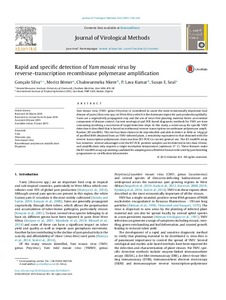| dc.contributor.author | Silva, G. |
| dc.contributor.author | Bömer, M. |
| dc.contributor.author | Nkere, C. |
| dc.contributor.author | Kumar, P.L. |
| dc.contributor.author | Seal, S.E. |
| dc.date.accessioned | 2019-12-04T10:57:57Z |
| dc.date.available | 2019-12-04T10:57:57Z |
| dc.date.issued | 2015 |
| dc.identifier.citation | Silva, G., Bömer, M., Nkere, C., Kumar, P.L., & Seal, S.E. (2015). Rapid and specific detection of yam mosaic virus by reverse-transcription recombinase polymerase amplification. Journal of Virological Methods, 222, 138-144. |
| dc.identifier.issn | 0166-0934 |
| dc.identifier.uri | https://hdl.handle.net/20.500.12478/880 |
| dc.description.abstract | Yam
mosaic
virus
(YMV;
genus
Potyvirus
)
is
considered
to
cause
the
most
economically
important
viral
disease
of
yams
(
Dioscorea
spp.)
in
West
Africa
which
is
the
dominant
region
for
yam
production
globally.
Yams
are
a
vegetatively
propagated
crop
and
the
use
of
virus-free
planting
material
forms
an
essential
component
of
disease
control.
Current
serological
and
PCR-based
diagnostic
methods
for
YMV
are
time
consuming
involving
a
succession
of
target
detection
steps.
In
this
study,
a
novel
assay
for
specific
YMV
detection
is
described
that
is
based
on
isothermal
reverse
transcription-recombinase
polymerase
ampli-
fication
(RT-exoRPA).
This
test
has
been
shown
to
be
reproducible
and
able
to
detect
as
little
as
14
pg/
l
of
purified
RNA
obtained
from
an
YMV-infected
plant,
a
sensitivity
equivalent
to
that
obtained
with
the
reverse
transcription-polymerase
chain
reaction
(RT-PCR)
in
current
general
use.
The
RT-exoRPA
assay
has,
however,
several
advantages
over
the
RT-PCR;
positive
samples
can
be
detected
in
less
than
30
min,
and
amplification
only
requires
a
single
incubation
temperature
(optimum
37
?
C).
These
features
make
the
RT-exoRPA
assay
a
promising
candidate
for
adapting
into
a
field
test
format
to
be
used
by
yam
breeding
programmes
or
certification
laboratoriesYam
mosaic
virus
(YMV;
genus
Potyvirus
)
is
considered
to
cause
the
most
economically
important
viral
disease
of
yams
(
Dioscorea
spp.)
in
West
Africa
which
is
the
dominant
region
for
yam
production
globally.
Yams
are
a
vegetatively
propagated
crop
and
the
use
of
virus-free
planting
material
forms
an
essential
component
of
disease
control.
Current
serological
and
PCR-based
diagnostic
methods
for
YMV
are
time
consuming
involving
a
succession
of
target
detection
steps.
In
this
study,
a
novel
assay
for
specific
YMV
detection
is
described
that
is
based
on
isothermal
reverse
transcription-recombinase
polymerase
ampli-
fication
(RT-exoRPA).
This
test
has
been
shown
to
be
reproducible
and
able
to
detect
as
little
as
14
pg/
l
of
purified
RNA
obtained
from
an
YMV-infected
plant,
a
sensitivity
equivalent
to
that
obtained
with
the
reverse
transcription-polymerase
chain
reaction
(RT-PCR)
in
current
general
use.
The
RT-exoRPA
assay
has,
however,
several
advantages
over
the
RT-PCR;
positive
samples
can
be
detected
in
less
than
30
min,
and
amplification
only
requires
a
single
incubation
temperature
(optimum
37
?
C).
These
features
make
the
RT-exoRPA
assay
a
promising
candidate
for
adapting
into
a
field
test
format
to
be
used
by
yam
breeding
programmes
or
certification
laboratories |
| dc.language.iso | en |
| dc.subject | Yams |
| dc.subject | Dioscorea |
| dc.subject | Mosaic Virus |
| dc.subject | Diagnosis |
| dc.title | Rapid and specific detection of Yam mosaic virus by reverse-transcription recombinase polymerase amplification |
| dc.type | Journal Article |
| dc.description.version | Peer Review |
| cg.contributor.crp | Roots, Tubers and Bananas |
| cg.contributor.affiliation | University of Greenwich |
| cg.contributor.affiliation | International Institute of Tropical Agriculture |
| cg.coverage.region | Africa |
| cg.coverage.region | West Africa |
| cg.coverage.country | Nigeria |
| cg.isijournal | ISI Journal |
| cg.authorship.types | CGIAR and advanced research institutes |
| cg.iitasubject | Yam |
| cg.iitasubject | Plant Diseases |
| cg.journal | Journal of Virological Methods |
| cg.howpublished | Formally Published |
| cg.accessibilitystatus | Limited Access |
| local.dspaceid | 76379 |
| cg.identifier.doi | https://dx.doi.org/10.1016/j.jviromet.2015.06.011 |

